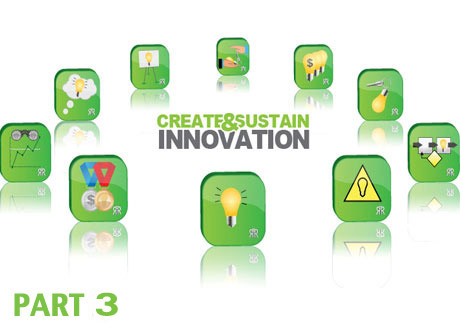By: Robert Brands
This is the third part in a series of articles that take the need of innovation under the loop and share some of the imperatives, must haves if you will, to create and sustain “NEW” in business or organizations. This article focuses on the new product developing process.
Innovation is the key to your company’s survival. It is an imperative and it must be an integral part of your organization. Innovation — it must be encoded in your corporate DNA. One of the most important parts in your innovation process is having an up to snuff new product development process.
The New Product Development Process
A formalized New Product Development NPD process is essential. Although alternative approaches exist the most common type is referred to as the Stage-Gate® Process (Stage-Gate ® is a registered trademark of Product Development Institute Inc.). The Stage-Gate innovation process is, according to its developers, ‘‘a carefully designed business process’’ and the result of comprehensive research into under- standing the reasons behind product success and failure (see www.stage-gate.com for more information). The process was pioneered by Dr. Robert G. Cooper and is widely used, and trusted, by companies around the world.
The process, in essence, has two key elements:
- The ‘‘stage’’ refers to the critical activities that need to be undertaken at a particular stage of product development. This is a cross-business process, and requires balanced ownership by multiple functions. Stage content, in my experience, should be divided among all business functions—it is not purely a technology process.
- The ‘‘gating’’ process involves ownership, decision makers, degree of flexibility, criteria, and prioritization. This includes a selection of ideas and concepts from the hopper.
Overall, it is important to note that the NPD process must be a cross-business function. Therefore, all business functions must be aware of the process. Communication of relevant information is essential. Key personnel should be involved in the go/no-go gating reviews.
 Metrics are essential
Metrics are essential
As for the reviews, these should be shared internally. Further, metrics are essential to demonstrate progress and create/encourage momentum and internal enthusiasm. Establishment of a mix of input metrics (such as average time in each stage), and output metrics, such as the value of launched products, percentage of new product sales, and so on, provides a balanced scorecard for innovation. Additionally, a streamlined, or ‘‘express’’ version of the process can be utilized for line extensions, to accelerate progress.

Is your process up to snuff?
I asked long-time associate and new product developer Jeff DeFazio how to determine whether one’s NPD process is up to snuff. He notes that ‘‘if sales of new products are less than 15 percent of total sales, check the composition of your innovation team, revisit your organization’s culture, and execute an informal self-audit that examines the type of new products you’re developing, the frequency of new product launches, and outside perceptions of your company.’’
As for the format for the NPD process, this can be as simple as an Excel spreadsheet, or matrix, or as detailed as the formal processes;
Innovation Implementation, with as many as six stages, simultaneous processes, go/no-go decisions, and so on, as such a straightforward approach typically includes:
- Idea generation and screening
- Concept development and business analysis
- Prototype development
- Scale-up/commercialization
- Launch
- Tracking and measurement
But even basic NPD efforts require a monthly updating and reprioritization.
According to DeFazio, ‘‘It’s better to spend more time up front in creating the NPD process, as this front-loading results in less time and wasted energy later on.’’ Typically, he said, innovation teams try to take up-front shortcuts and lose sight of the key goal of innovation: profitable growth.
“Create a structured, transparent process that allows management of project groups”
The key purpose of the NPD pipeline is to create a structured, transparent process that allows management of project groups, DeFazio explained. And the key elements include quality, capability, and capacity.
- In terms of quality, the innovation team strives to select projects that, if successful, will deliver the best strategic outcome for the invested funds.
- For capability, the process helps track how effectively an individual project is managed and allowed to progress.
- Capacity refers to how the business manages and prioritizes resources supporting a portfolio of well managed (or ‘‘capable’’) projects.
Remember what I mentioned in previous posts: Fail fast, but fail cheap. The institution of a proper NPD process will enhance your idea-to-launch methodology. Gates with ‘‘teeth’’ will help go/kill decision making and prioritization, define the gatekeepers, and provide a systematic approach to gatekeeping behavior.
Further, portfolio management will be simplified and flexible enough to achieve the optimal balance and mix of products in the hopper. Success criteria at the gates will be concretized, and, ideally, a financial overlay will further help prioritize projects against available resources.
The need of a robust post launch review
Institution of a robust post launch review is another key element in the process. Establishment of performance metrics measure how well a specific new product project performed. This is a powerful aid to understanding and analyzing results and learning how to improve future projects (see the next write up on Ownership). Stage-Gate is one of many forms of a formal step-by-step NPD process options to use and apply. Some of the others to consider include PDMA and SETR.
The importance and positive effect of a effective NPD process can not be underestimated. A large private company in adhesives and grout that operates globally added a structured NPD process and New Product sales grew from 6 to 18 percent over time.
What about the front end of the process, the so-called funnel? Many organizations now modify the front end of the NPD process to feature more opportunity for experimentation. At the same time, they rely less on financial go/ kill criteria, and more on strategic go/kill criteria.
More to follow in my next article on ideation. There, you’ll see how we take our ‘‘wild idea’’ from a gleam in the eye (dream), through the discovery phase, to design, then development, and, finally, delivery.
New Product Development Tips
Remember, “creative” and “structured” need not be mutually exclusive concepts.
- Open Wide: Keep the idea funnels wide open. As Stage-Gate’s Dr. Cooper advises, find and fill the product “white spaces” – untapped marketplace opportunities.
- Sharpen Those Teeth: Make sure your Go/No-Go decision checkpoints have “teeth.”
- Widen the Innovation Highway: Make the system lean, adaptive, flexible and scalable, in order that you can simultaneously process different types and risk levels of projects.
For additional information and blogs see:
- Fostering Creativity with Structure
- New Product Development Requires Fresh Perspective on ‘Creative’ and ‘Structure’
- For definition and more information on NPD click here
By Robert F. Brands

About the Author
 Robert F. Brands is President and founder of Brands & Company, LLC. Having gained hands-on experience in bringing innovation to market, creating and improving the necessary product development processes and needed culture, he delivered and exceeded to bring “at least one new product per year to market” resulting in double digit profitable growth and shareholder value.
Robert F. Brands is President and founder of Brands & Company, LLC. Having gained hands-on experience in bringing innovation to market, creating and improving the necessary product development processes and needed culture, he delivered and exceeded to bring “at least one new product per year to market” resulting in double digit profitable growth and shareholder value.
Robert is the founder of Innovation Coach.com, he is an innovation speaker and the author of “Robert’s Rules of Innovation, a 10-Step Program for Corporate Survival” with Martin Kleinman published March, 2010 by Wiley. The book contains assessment tools, tips, in depth chapters on the importance of Intellectual Property, working with multinational teams and more. For more information on Inspire & Initiate or any of the other imperatives please visit RobertsRules ofInnovation.com.


 Metrics are essential
Metrics are essential